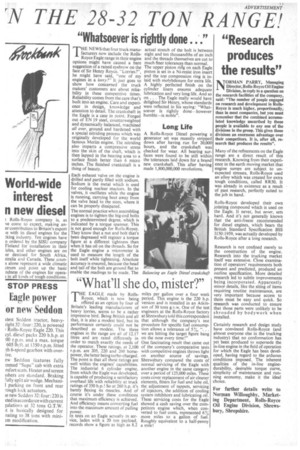"Research produces the results"
Page 13

If you've noticed an error in this article please click here to report it so we can fix it.
ORMAN PARRY, Managing
Director, Rolls-Royce Oil Engine Division, in reply to a question on the research facilities of the company, said: "The number of people engaged on research and development in RollsRoyce is much higher, proportionally, than in most companies, but you must remember that the combined accumulated knowledge unearthed by those people is available to any one of the divisions in the group. This gives those divisions an enormous advantage over their competitors. It is, after all, research that produces the results".
Many of the refinements on the Eagle range are a direct result of this research. Knowing from their experience in the earth moving market that engine sumps are subject to unexpected stresses, Rolls-Royce used an alloy which was created for extra tough conditions, called RR50. It was already in existence as a result of past research, perfectly suited to the job in hand.
Rolls-Royce developed their own jointing compound which is used on the Eagle. It never, but never, sets hard. And it's not generally known that the anti-freeze recommended for diesel engines, which bears the British Standard Specification BSS 3150:1959, was actually developed by Rolls-Royce after a long research.
Research is not confined merely to the construction of the engine. Research into the trucking market itself was extensive. Close examination of operators' requirements both present and predicted, produced an outline specification. More detailed research led to subtle improvements being incorporated. Apparently minor details, like the siting of items requiring routine maintenance, are very important because access to them must be easy and quick. So research was conducted to ensure that those parts were unlikely to be shrouded by bodywork when installed.
Certainly research and design study have convinced Rolls-Royce (and almost everyone else in the trucking industry) that no conformation has yet been produced to supersede the in-line engine in the field of operation for which the Eagle has been developed, having regard to the arduous conditions imposed. The inherent qualities of the in-line enginedurability, desirable torque curve, simplicity of maintenance and running economy, make it the ideal choice.
For further details write to Norman Willoughby, Marketing Department, Rolls-Royce Oil Engine Division, Shrewsbury, Shropshire.




































































































































































































































































